
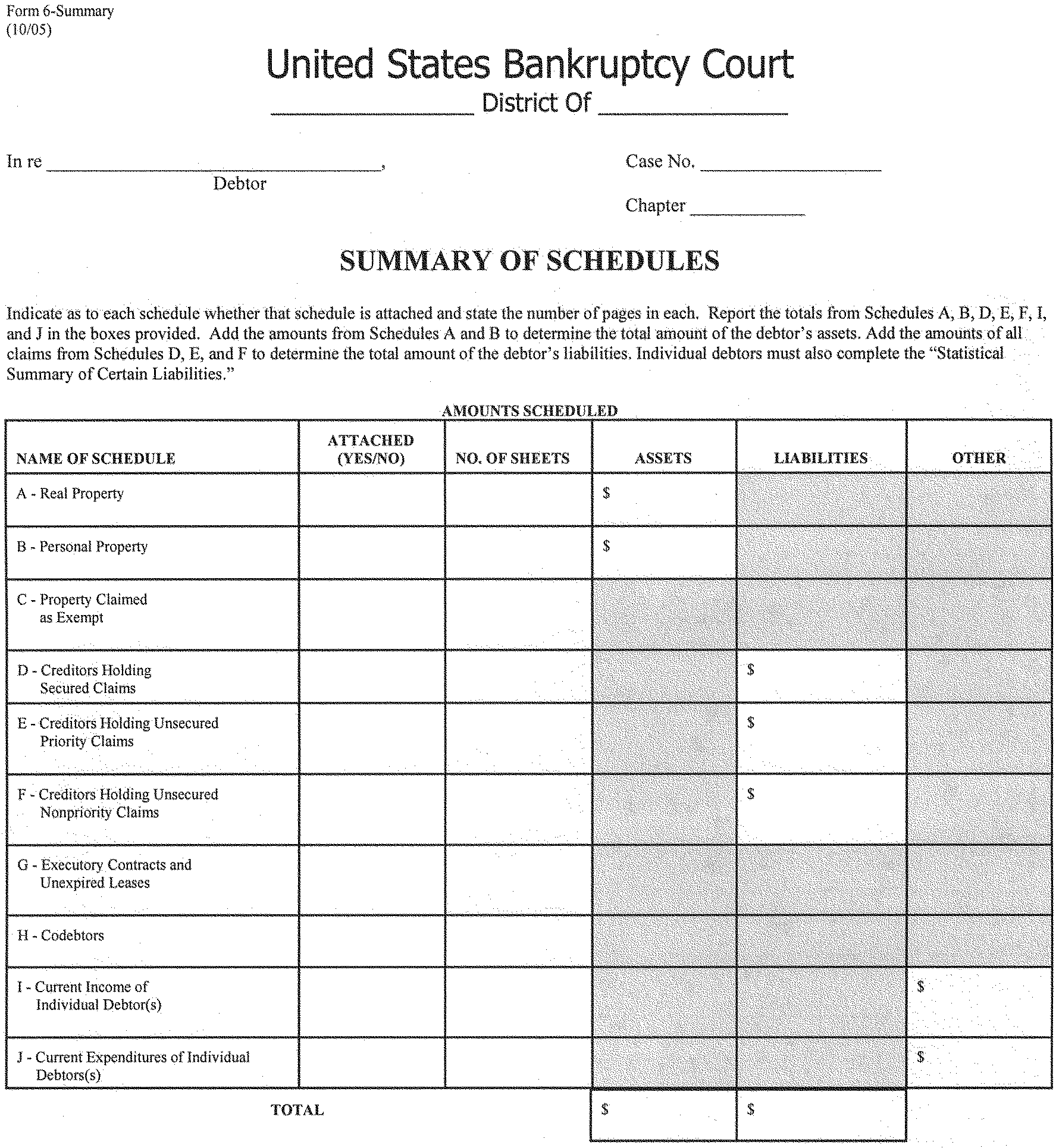
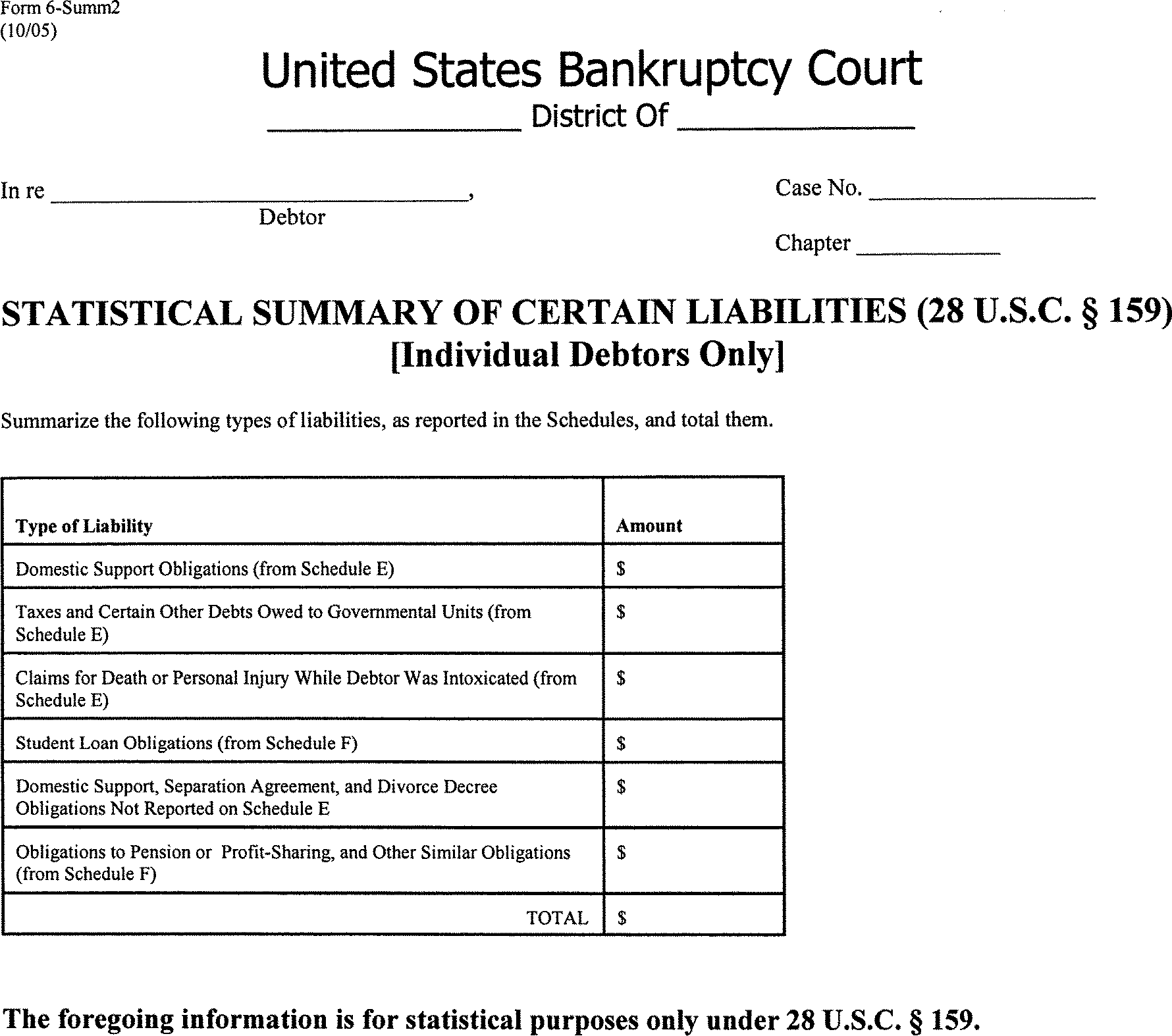
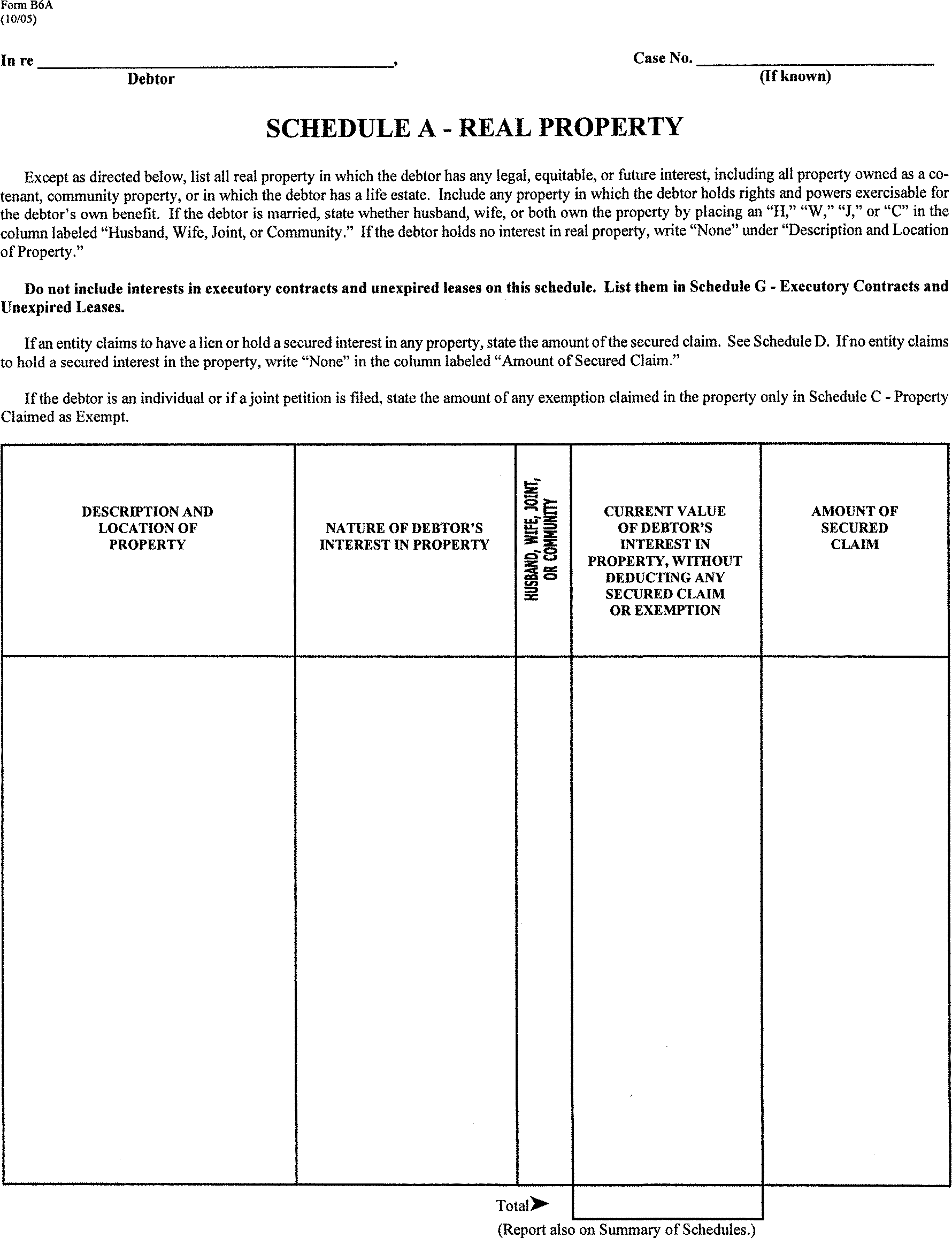
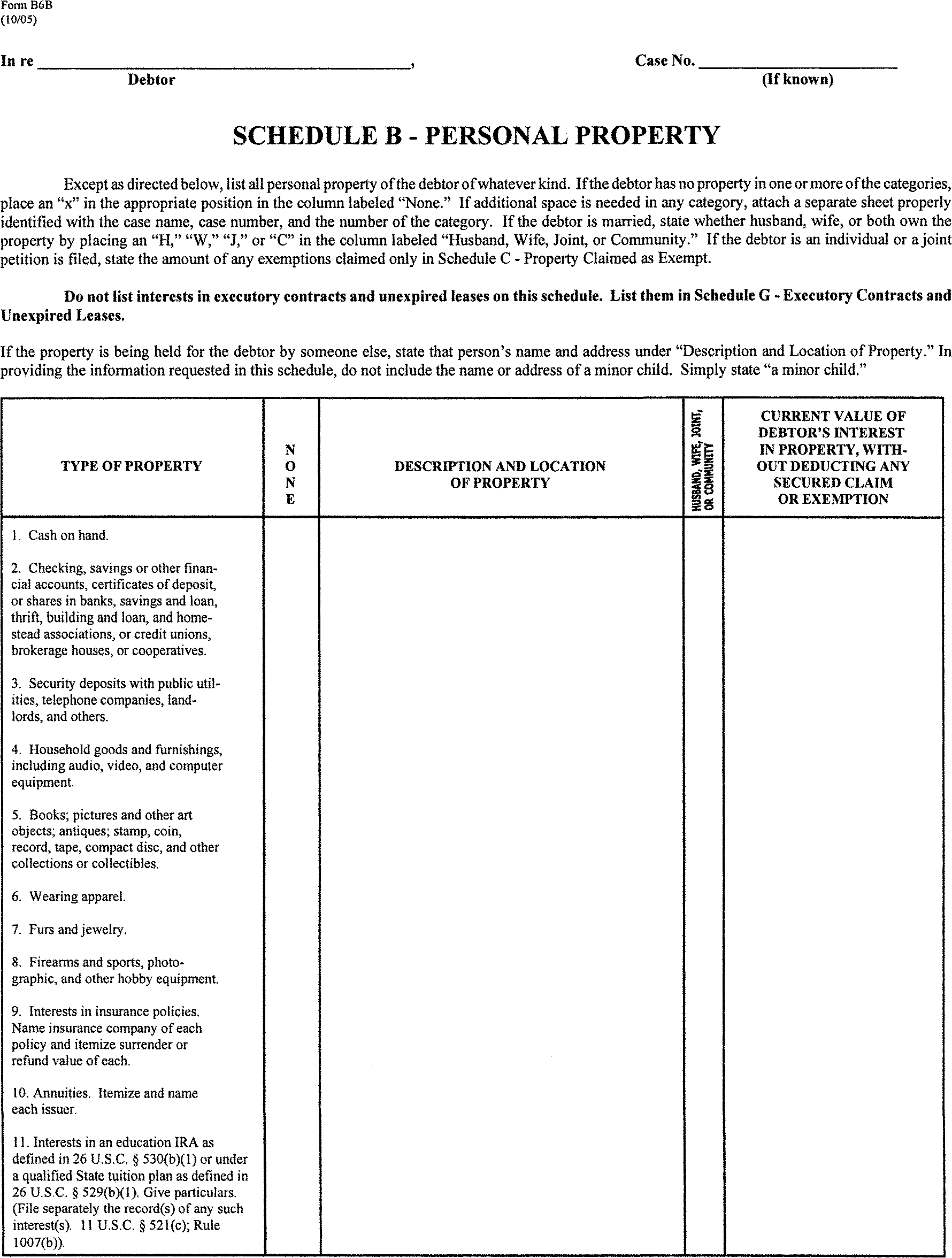
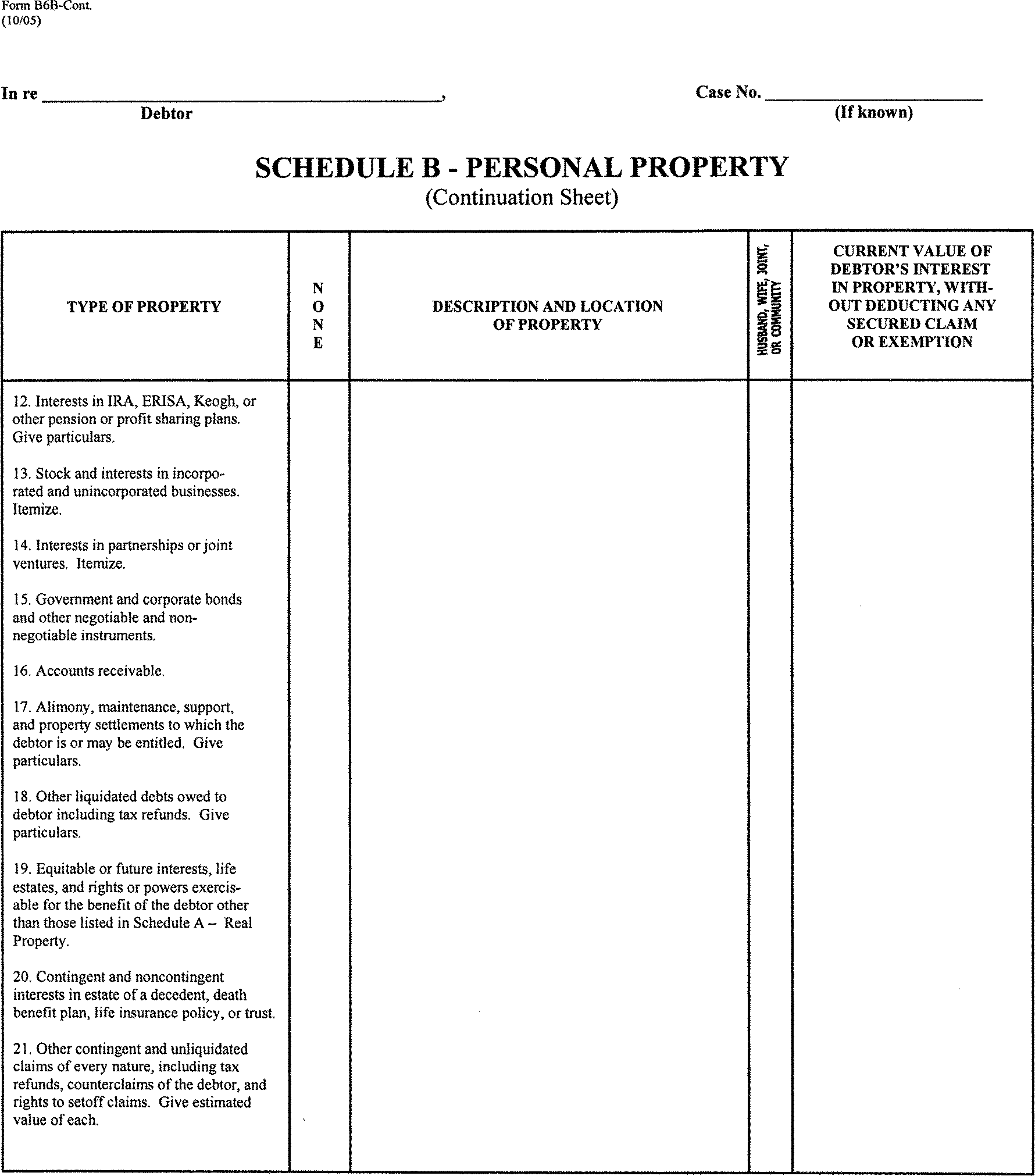

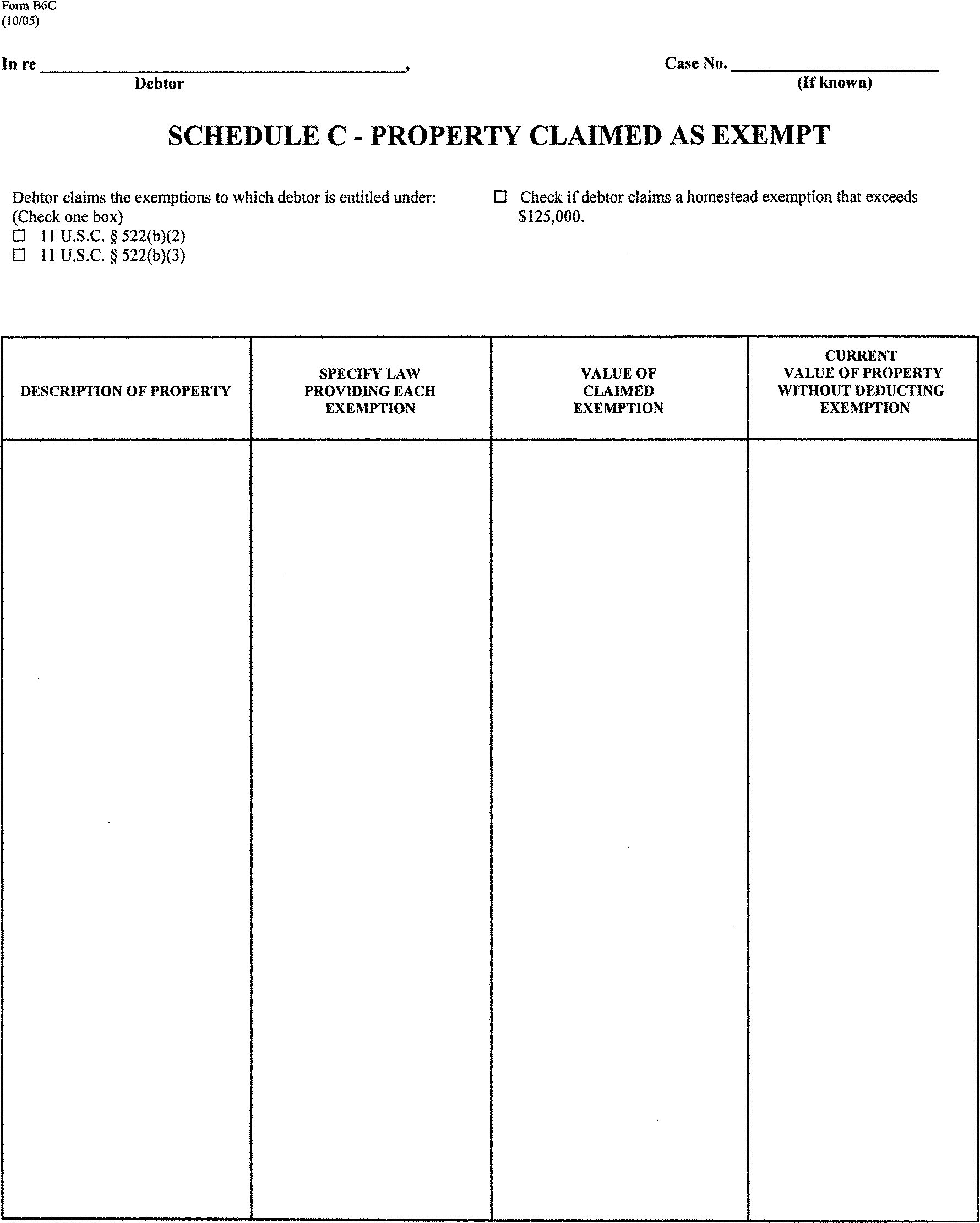
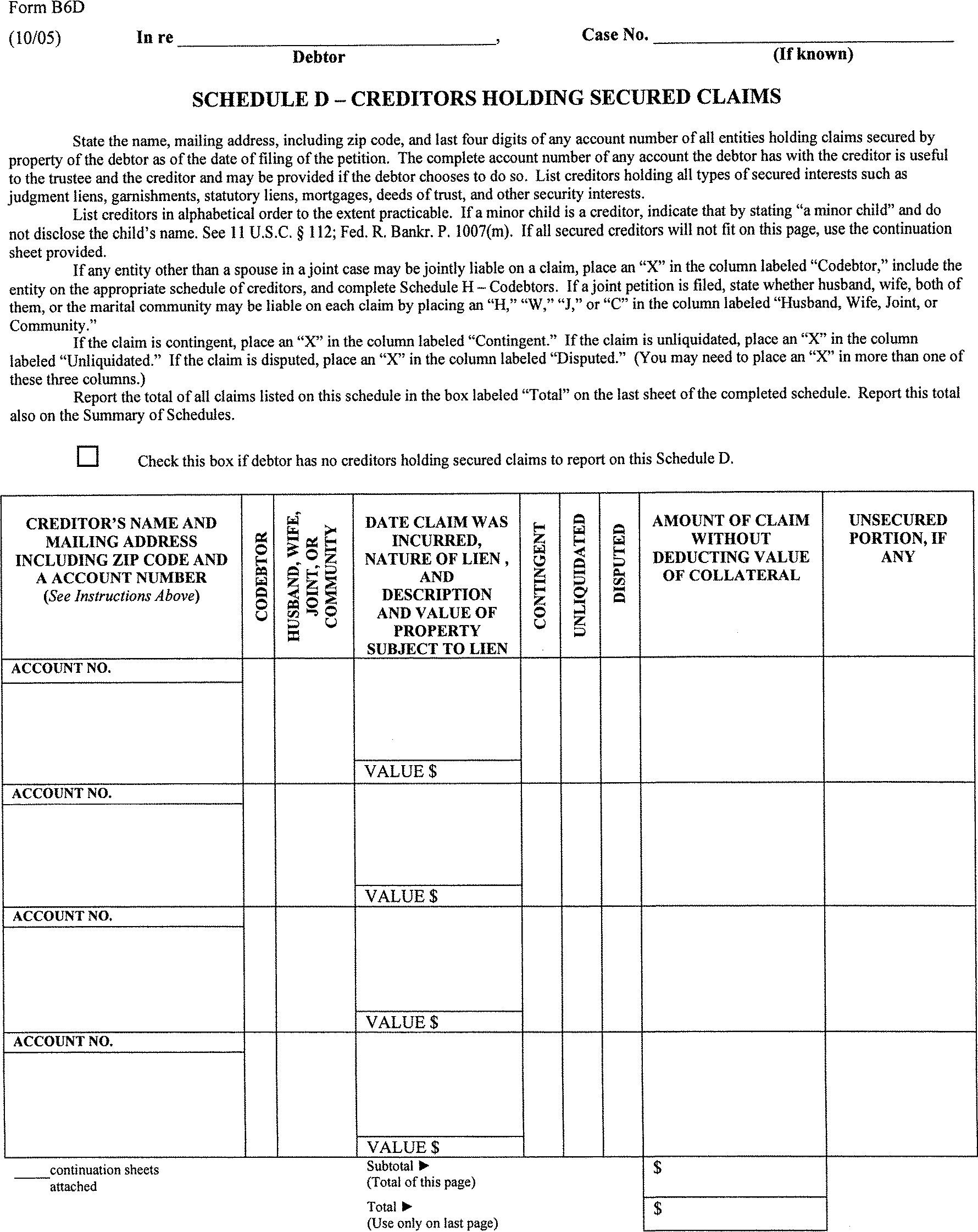
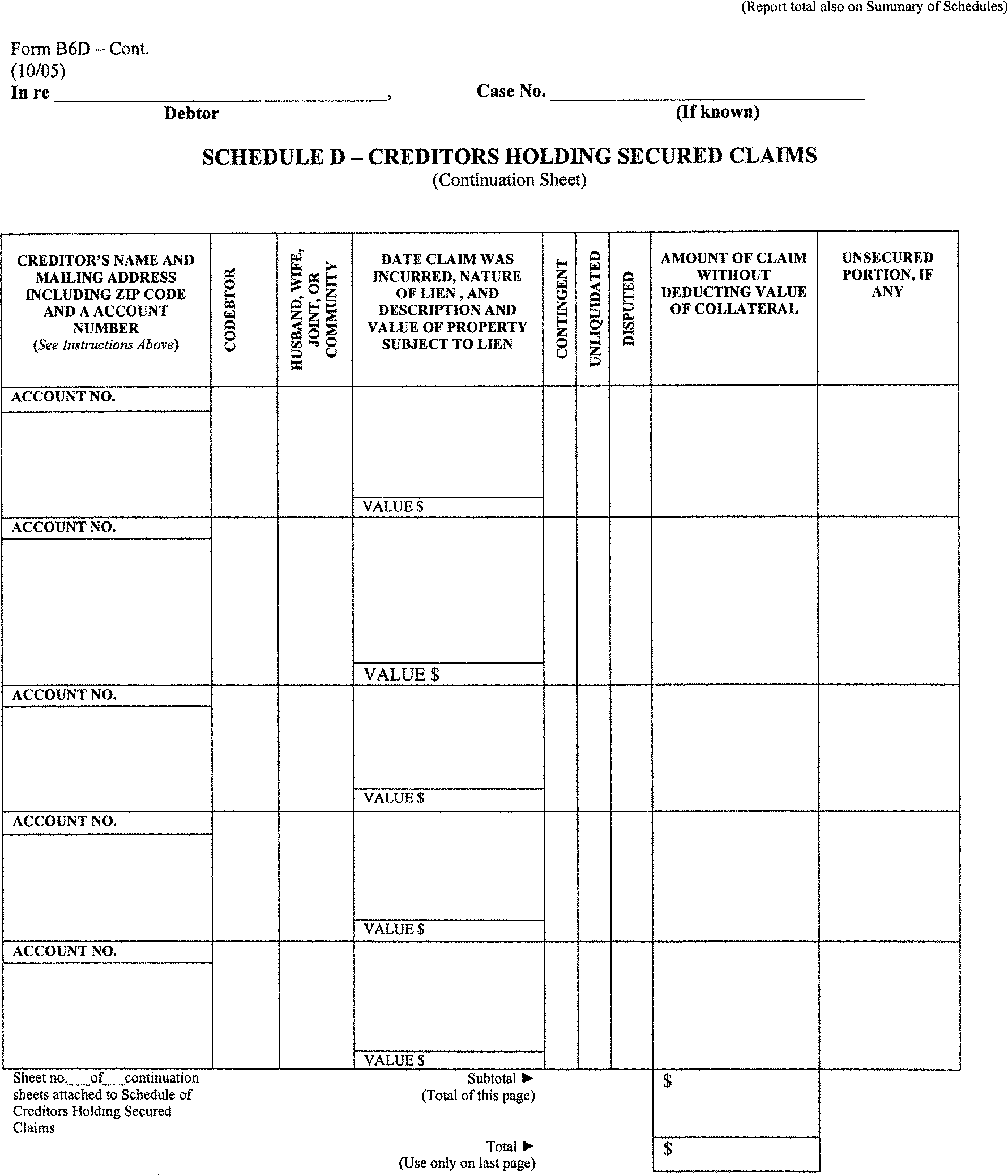
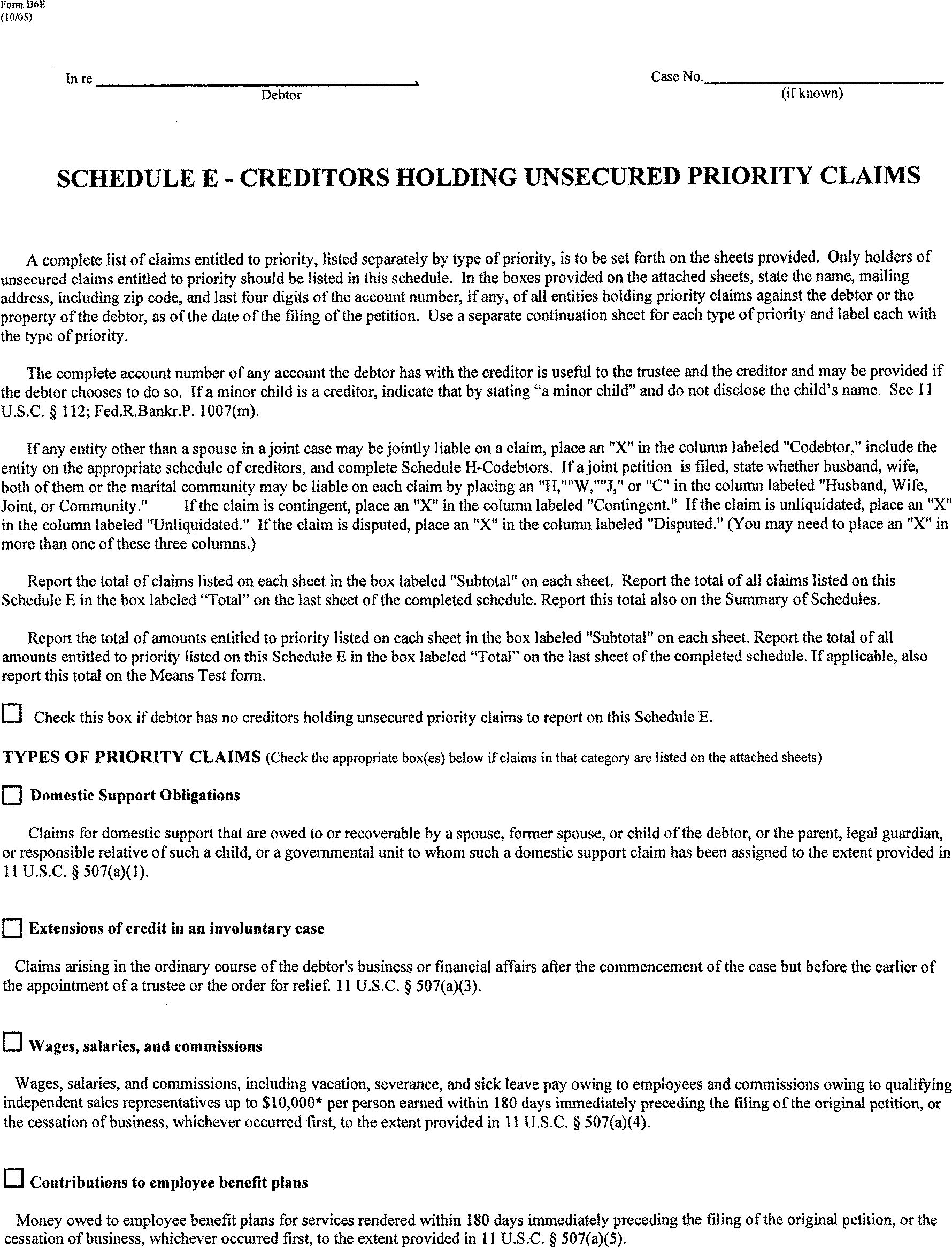
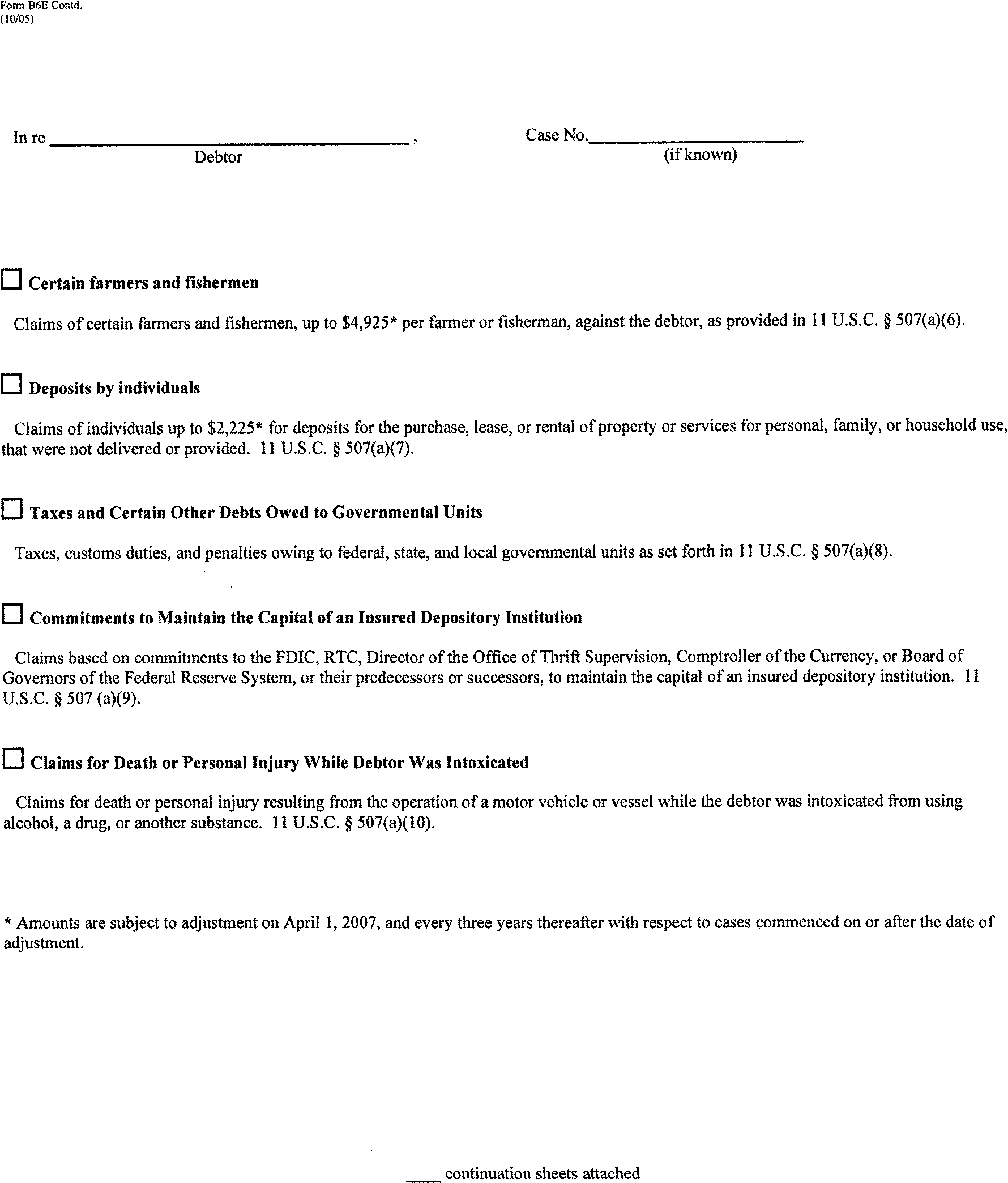
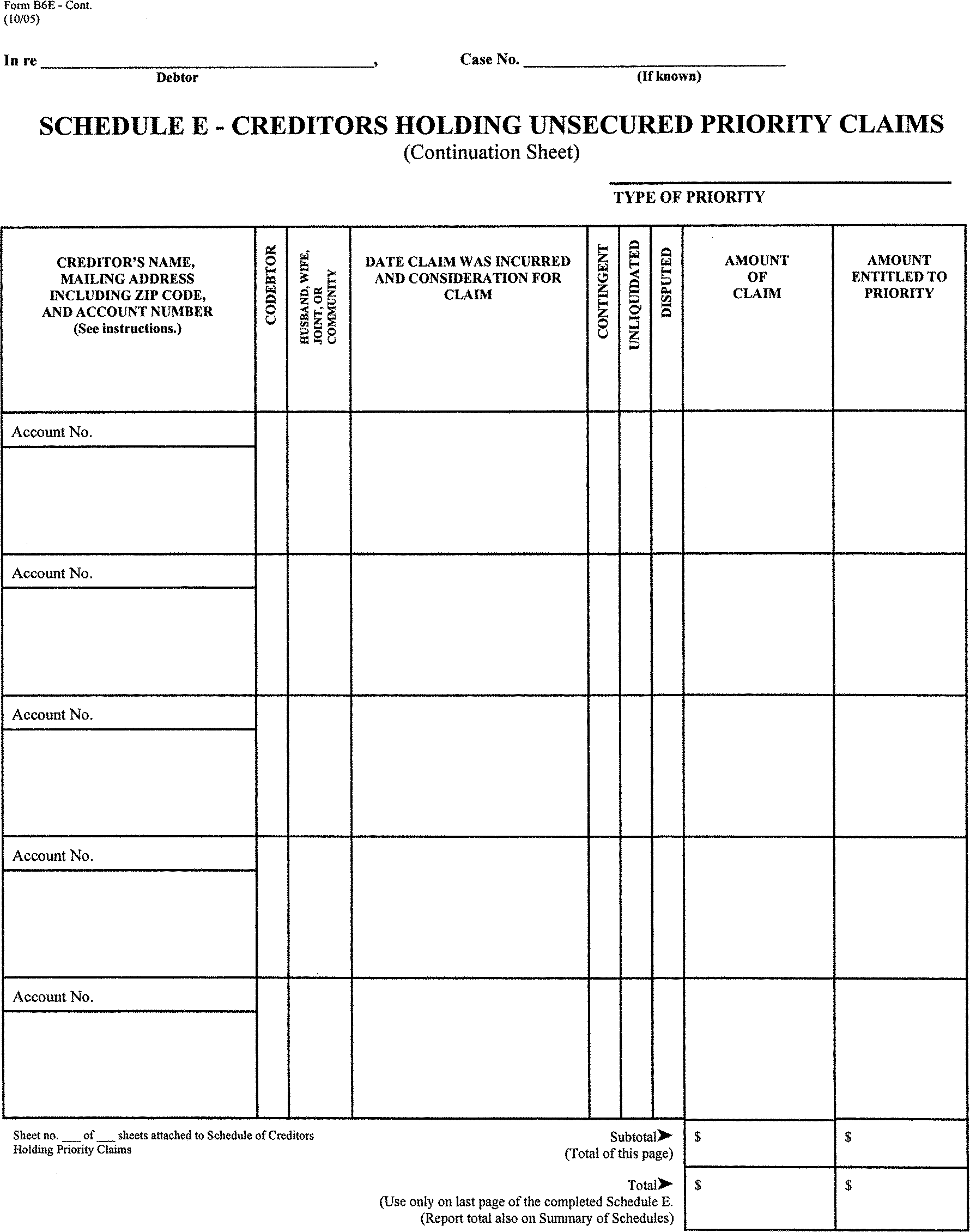
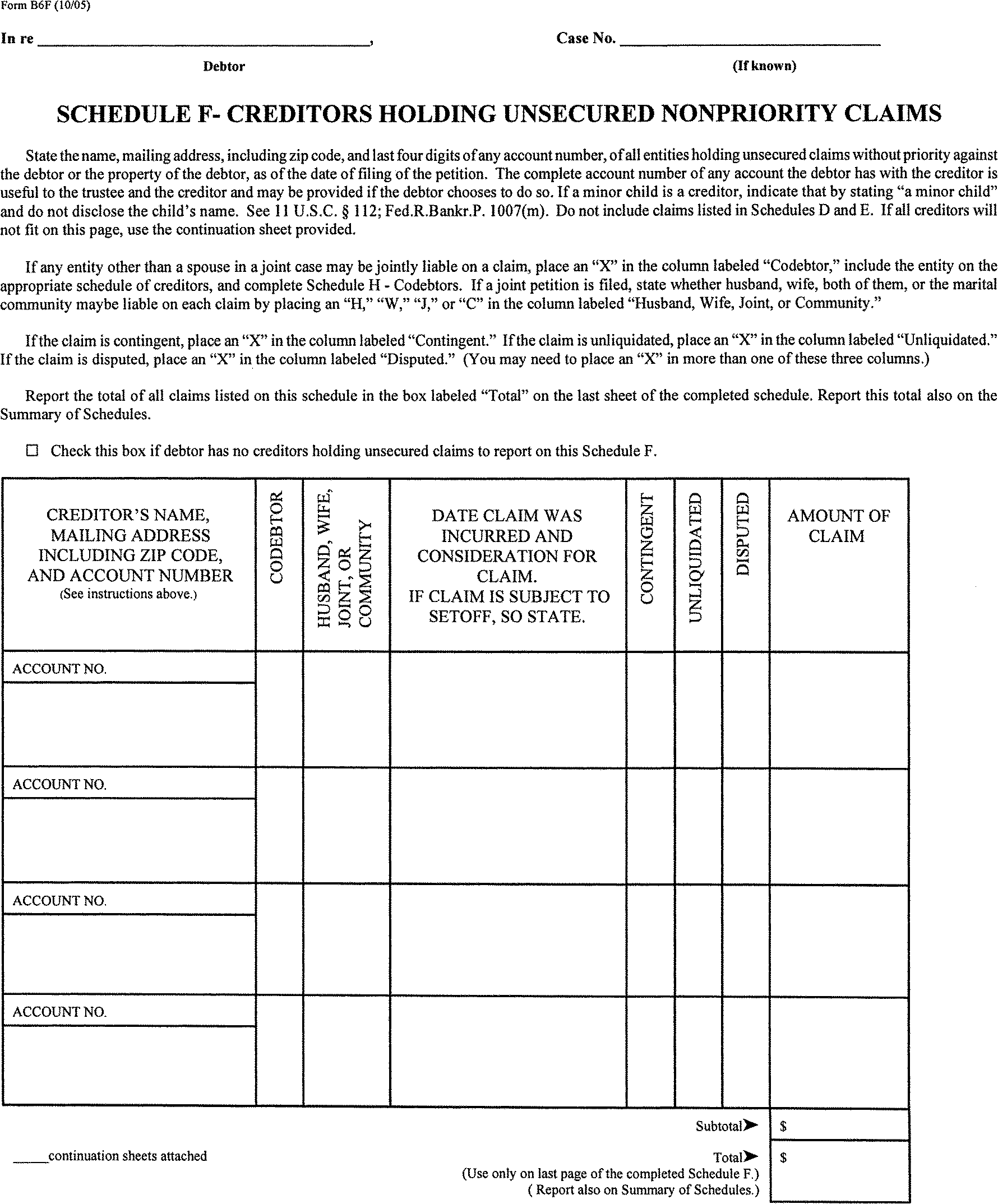
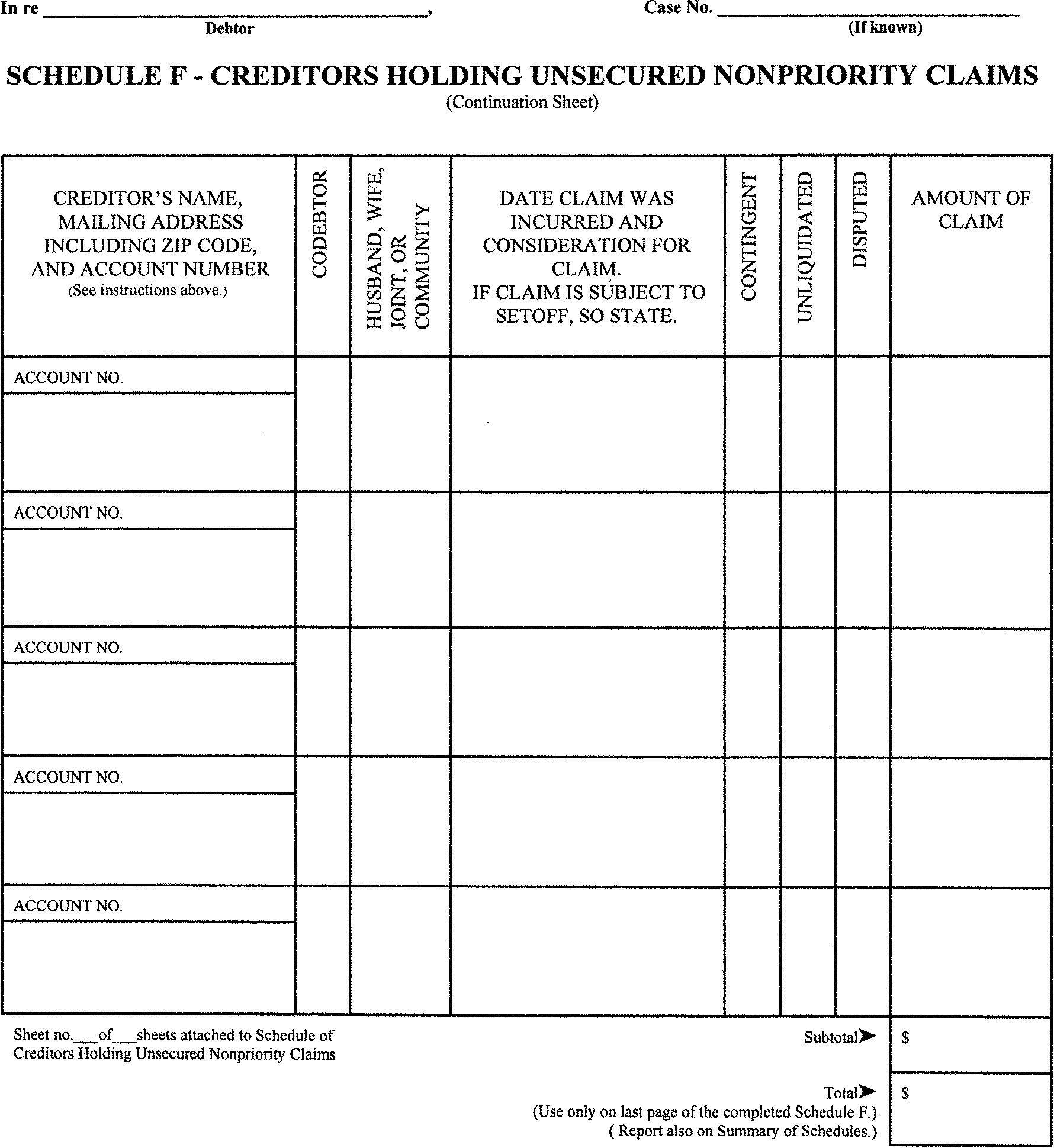
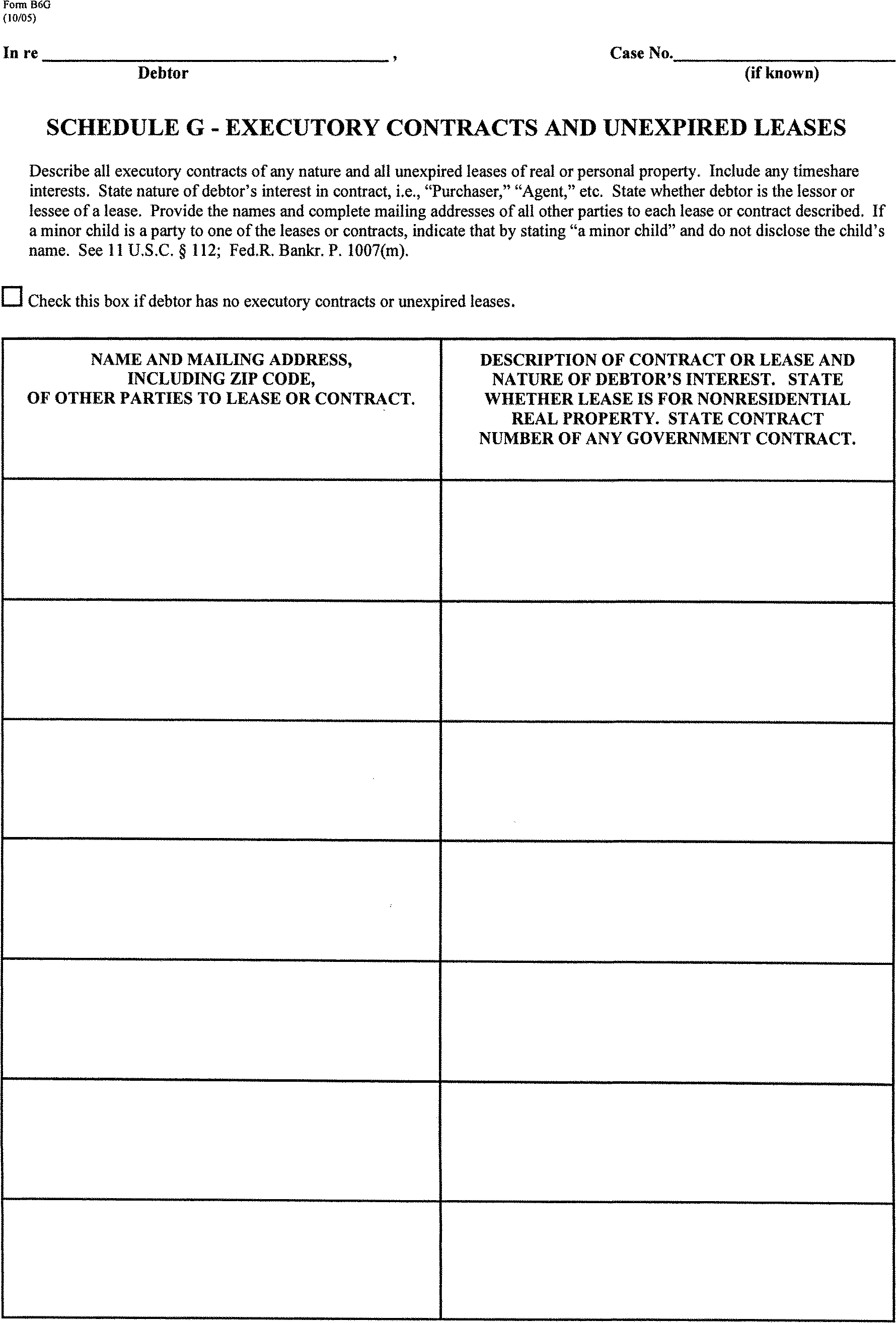

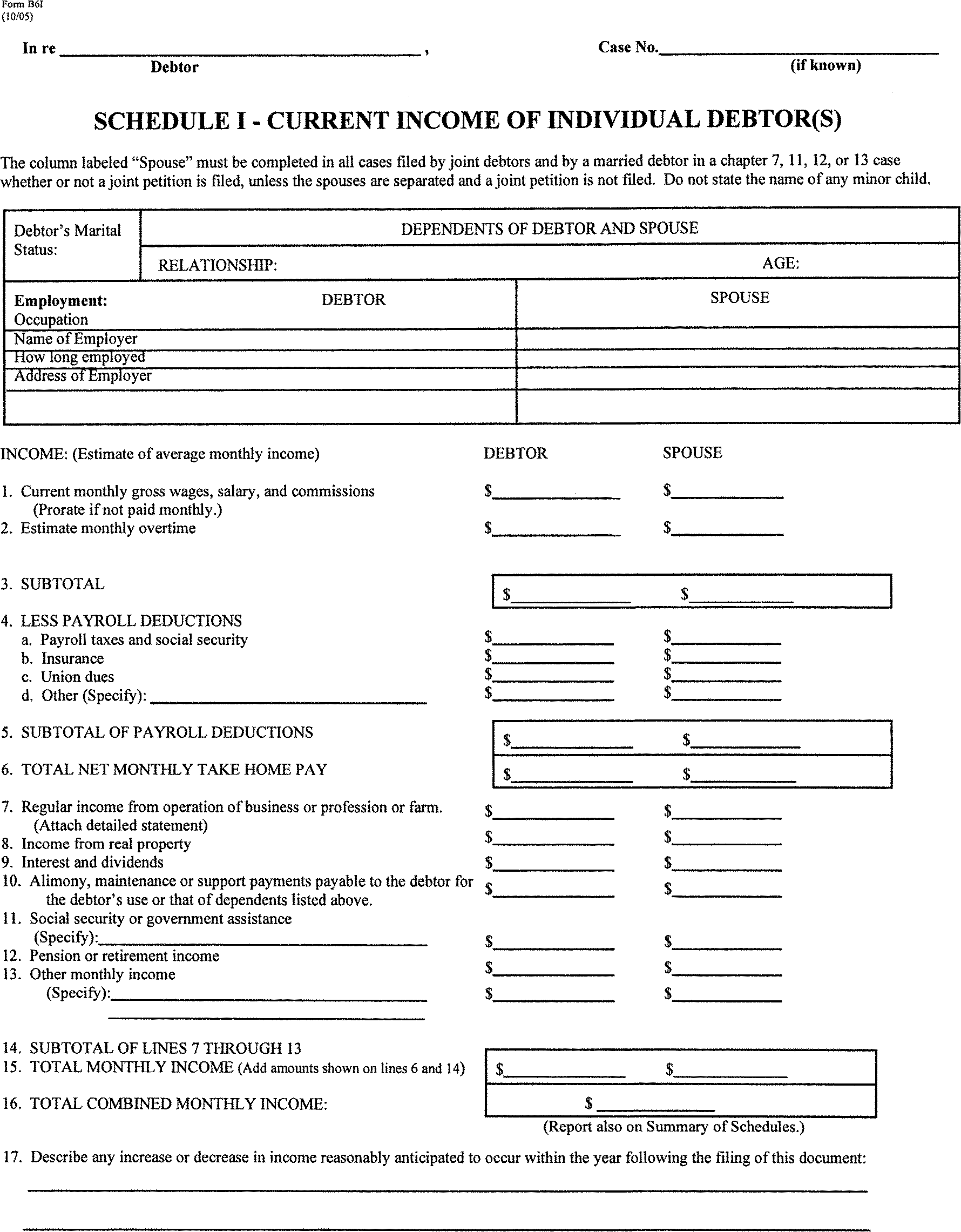


(Added Aug. 1, 1991; amended Mar. 16, 1993; Mar. 14, 1995; Oct. 1, 1997; Dec. 1, 2003; Oct. 17, 2005; Oct. 1, 2006.)
These schedules shall be used to comply with §521(1) of the Code and Rule 1007(b). Schedules A, B, D, E, and F constitute the schedule of assets and liabilities. Schedules I and J constitute a schedule of current income and current expenditures for individual and joint debtors. Two new schedules have been created, Schedule G—Executory Contracts and Unexpired Leases, and Schedule H—Codebtors.
The order of the schedules has been arranged with the summary sheet in front and with the schedules of assets appearing first, followed by the schedules of liabilities. This structure corresponds to the customary pattern by which trustees and creditors review these documents and to the format of the accounting profession for balance sheets.
The schedules require a complete listing of assets and liabilities but leave many of the details to investigation by the trustee. Instructions in the former schedules to provide details concerning “written instruments” relating to the debtor's property or debts have been deleted. Section 521(3) of the Code requires the debtor to cooperate with the trustee, who can administer the estate more effectively by requesting any documents from the debtor rather than relying on descriptions in the schedules which may prove to be inaccurate.
Leasehold interests in both real and personal property are to be reported in Schedule G—Executory Contracts and Unexpired Leases. This information should not be repeated in the schedules of assets.
Generally in these schedules, a creditor's claim will be listed only once, even if the claim is secured only in part, or is entitled only in part to priority under §507(a) of the Code, with the remainder of the claim to be treated as a general unsecured claim. For example, a partially secured creditor whose claim is reported in Schedule D—Creditors Holding Secured Claims will be listed together with the value of the property securing the claim and a notation of the amount of any unsecured portion of the claim. Information concerning the unsecured portion should not be repeated in Schedule F—Creditors Holding Nonpriority Unsecured Claims. Any resulting overstatement of the amounts owed on secured and priority claims as reported on the summary sheet is offset by a corresponding understatement of the amount owed on unsecured claims.
If a debtor has no property or no creditors in a particular category, an affirmative statement to that effect is required. Married debtors should indicate whether property is jointly or separately owned and whether spouses are jointly or separately liable for debts, using the columns provided in the schedules.
Former “Schedule B–3. Property not otherwise scheduled,” has been deleted and its two questions moved. Schedule B—Personal Property now includes at item 33, “Other personal property of any kind not already listed.” The only other question on former Schedule B–3 concerned assignments for the benefit of creditors; it has been moved to the Statement of Financial Affairs.
Schedule A—Real Property. Instructions at the top of the form indicate the scope of the interests in property to be reported on the schedule. Leasehold interests of the debtor are not reported here but on the Schedule of Executory Contracts and Unexpired Leases. The trustee will request copies of deeds or other instruments necessary to the administration of the estate.
Schedule B—Personal Property. This schedule is to be used for reporting all of the debtor's interests in personal property except leases and executory contracts, which are to be listed on the Schedule of Executory Contracts and Unexpired Leases. Several new categories of property have been added to the schedule, i.e., aircraft, and interests in IRA, ERISA, Keogh, or other pension or profit-sharing plans. To minimize the potential for concealment of assets, the debtor must declare whether the debtor has any property in each category on the schedule. The trustee can request copies of any documents concerning the debtor's property necessary to the administration of the estate.
Schedule C—Property Claimed as Exempt. The form of the schedule has been modified to eliminate duplication of information provided elsewhere. The location of property, for example, which formerly was required here, is disclosed in the schedules of real and personal property. The requirement that the debtor state the present use of the property also has been eliminated as best left to inquiry by the trustee. Exemptions in some states are granted by constitutional provisions; accordingly, the requirement that the debtor state the “statute” creating an exemption has been changed to request a statement of the relevant “law.”
This schedule adds a new requirement that the debtor state the market value of the property in addition to the amount claimed as exempt.
Schedule D—Creditors Holding Secured Claims. Schedules D, E, and F have been redesigned with address boxes sized to match the number of characters which can be accommodated on the computerized noticing systems used by the courts. The size also closely approximates that of standard mailing labels. Space is designated at the top of the box for the debtor's account number with the creditor. The design of the form is intended to reduce the volume of misdirected creditor mail.
The form requires the debtor to state affirmatively that a claim is disputed, unliquidated, or contingent. The existence of any type of codebtor is to be disclosed, but details are to be provided in Schedule H, as they are not needed here. Duplication of information also has been kept to a minimum by deleting requests that the debtor indicate on this schedule whether a debt has been reduced to judgment and the date on which a creditor repossessed any collateral. Requests for details concerning negotiable instruments and the consideration for a claim, formerly part of the schedule, are left to the trustee's inquiries.
Schedule E—Creditors Holding Unsecured Priority Claims. The schedule lists all of the types of claims entitled to priority and requires the debtor to indicate the existence of claims in each category. Continuation sheets are provided. The type of priority claim is to be noted at the top of the continuation sheet, and each type must be reported on a separate sheet. This schedule also requires the debtor to indicate the existence of any codebtors. As in Schedule D—Creditors Holding Secured Claims, requests for information concerning judgments and negotiable instruments have been deleted.
Schedule F—Creditors Holding Unsecured Nonpriority Claims. This schedule has been revised generally in conformity with the other schedules of creditors. If a claim is subject to setoff, the debtor is required to so state.
Schedule G—Executory Contracts and Unexpired Leases. Rule 1007(b) requires the debtor to file a schedule of executory contracts and unexpired leases, unless the court orders otherwise. All unexpired leases of either real or personal property are to be reported on this schedule. The schedule also requires the debtor to disclose specific information to assist the trustee in identifying leases which must be assumed within 60 days after the order for relief or be deemed rejected under §365(d) of the Code.
Schedule H—Schedule of Codebtors. This schedule is designed to provide the trustee and creditors with information about codebtors of all types other than spouses in joint cases. The completed schedule provides information concerning non-debtor parties, such as guarantors and non-debtor spouses having an interest in property as tenants by the entirety. In chapter 12 and chapter 13 cases, the completed schedule also indicates those persons who may be entitled to certain protections from creditor action under §§1201 and 1301 of the Code.
Schedule I—Schedule of Current Income of Individual Debtor(s) and Schedule J—Schedule of Current Expenditures of Individual Debtor(s). Former Official Form No. 6A has been divided into a schedule of current income and a separate schedule of current expenditures. The language is substantially the same as in former Official Form No. 6A. In light of the abrogation of Official Form No. 10, the Chapter 13 Statement, style changes have been made so that these schedules can be used by individual and joint debtors in all chapters.
Schedule E (Creditors Holding Unsecured Priority Claims) has been changed to conform to the statutory amendment that added subsection (a)(8) to §507 of the Code. Pub. L. No. 101–647, (Crime Control Act of 1990), added the new subsection, which had the effect of creating an eighth priority for claims of certain governmental units based on commitments to maintain the capital of an insured depository institution.
Schedule E—Creditors Holding Unsecured Priority Claims is amended to add the new seventh priority afforded to debts for alimony, maintenance, or support of a spouse, former spouse, or child of the debtor by the Bankruptcy Reform Act of 1994. Statutory references are amended to conform to the paragraph numbers of section 507(a) of the Code as renumbered by the 1994 Act. Schedule E also is amended to add commissions owed to certain independent sales representatives and to raise the maximum dollar amounts for certain priorities in accordance with amendments made by the 1994 Act to section 507(a) of the Code. The 1994 Act also amended section 104 of the Code to provide for future adjustment of the maximum dollar amounts specified in section 507(a) to be made by administrative action at three-year intervals to reflect changes in the consumer price index. Schedule E is amended to give notice that these dollar amounts are subject to change without formal amendment to the official form.
The Schedules are a “document for filing” that may be prepared by a “bankruptcy petition preparer” as defined in 11 U.S.C. §110, which was added to the Code by the 1994 Act; accordingly, a signature line for such preparer is added. In addition to signing, a bankruptcy petition preparer is required by section 110 to disclose the information requested.
The form is amended to add to the column labels a reference to community liability for claims. The amendment is technical and corrects an editorial oversight.
The instructions to Schedule D (Creditors Holding Secured Claims), Schedule E (Creditors Holding Unsecured Priority Claims), and Schedule F (Creditors Holding Unsecured Nonpriority Claims) are amended to inform the debtor that the debtor must list the last four digits of any account number with the listed creditor, and that the debtor may, in its discretion, include the entire account number in the schedules. Schedule I (Current Income of Individual Debtor(s)) is amended to provide greater privacy to minors and other dependents of the debtor by deleting the requirement that the debtor disclose their names. Pursuant to §110(c) of the Bankruptcy Code, the certification by a non-attorney bankruptcy petition preparer requires a petition preparer to provide the full social security number of the individual who actually prepares the document.
The forms of the Schedules of Assets and Liabilities are amended to implement the provisions of the Bankruptcy Abuse Prevention and Consumer Protection Act of 2005, Pub. L. No. 109–8, 119 Stat. 23, (April 20, 2005). An amendment that directs the debtor to avoid disclosing the name of any minor child occurs in several of the schedules in conformity with §112 which was added to the Code in 2005. Section 112 provides for the debtor to provide the name of any minor child confidentially to the court, should the trustee need the information to evaluate properly the information filed by the debtor.
The “Statistical Summary of Certain Liabilities” is added to collect information needed to prepare statistical reports required under 28 U.S.C. §159, which was enacted as part of the 2005 Act.
Schedules A, B, C, and D are amended to delete the word “market” from the columns in which the debtor reports the value of various kinds of property. Amendments to §506 of the Code enacted in 2005 specify that “replacement value” must be used in connection with certain property. The schedules no longer specify “market” value and permit the debtor to choose the appropriate one, whether that be replacement, market, or some other value. Valuation of property, generally, is the subject of extensive provisions in the Code, and the deletion of the word “market” from the determinations of value to be made by the debtor on the schedules is intended to remove any inference about choice of valuation standard. This deletion simply indicates that the form takes no position on which Code provision or valuation standard may be applicable in any instance.
The following paragraphs describe changes that are specific to each schedule.
Schedule B—Personal Property is amended to require the debtor to list any interests in an education IRA, as §541(b)(5), added to the Code in 2005, makes special provision for them. The schedule also is amended to require the debtor to disclose the existence of any customer lists or other compilations containing personally identifiable information provided by an individual to the debtor in connection with obtaining a product or service from the debtor for personal, family, or household purposes. This amendment implements §332, which was added to the Code in 2005.
Schedule C—Property Claimed as Exempt is amended to delete descriptive information concerning the length of domicile required for the debtor to qualify to claim certain exemptions. Any summary of the amendments enacted in 2005 to §522 of the Code concerning these requirements might inadvertently cause the debtor to lose important rights. Accordingly, the form now directs the debtor to indicate whether exemptions are being claimed under §522(b)(2) or §522(b)(3) and whether the debtor claims a homestead exemption that exceeds $125,000.
Schedule E—Creditors Holding Unsecured Priority Claims is amended to implement the changes in priority to which a claim may be entitled under 11 U.S.C. §507 as amended by the 2005 Act and to add the new priority included in the Reform Act for claims for death or personal injury while the debtor was intoxicated. “Subtotal” and “Total” boxes have been added to the column labeled “Amount Entitled to Priority” to assist the individual debtor to complete the Current Monthly Income (“CMI” or “Means Test”) form.
Schedule G—Executory Contracts and Unexpired Leases is amended by deleting the note to the debtor advising that parties listed on this schedule may not receive notice of the filing of the bankruptcy case unless they also are listed on one of the schedules of liabilities. The better practice is for all parties to transactions with the debtor to receive notice of the filing of the case, and an amendment to Rule 1007 requiring the debtor to provide a mailing list that includes these parties is scheduled to take effect December 1, 2005.
Schedule H—Codebtors is amended to add specifics about community property jurisdictions in connection with the requirement to provide the name of any spouse of a debtor who resides or resided in a community property jurisdiction. This amendment also mirrors amendments made in 1997 to Official Form 7, the Statement of Financial Affairs, and will assure that these codebtors receive notice of the filing of the bankruptcy case. The form also is amended to extend from six years to eight years the time period for which this information is reported pursuant to the 2005 amendments to §727(a)(8) of the Code.
Schedule I—Current Income of Individual Debtor(s) is amended to require the income of a nondebtor spouse to be reported in cases filed under chapters 7 and 11. Line numbers have been added to assist the debtor in calculating and reporting totals. A new subtotal line for income from sources other than as an employee and a new “total monthly income” line provide for this form to be used in conjunction with Schedule J to satisfy the requirements of §521(a)(1)(B)(v), which was added to the Code in 2005. The form also has been revised to provide the statement concerning any anticipated increase or decrease in income required in §521(a)(1)(B)(vi), which also was added to the Code in 2005.
Schedule J—Current Expenditures of Individual Debtor(s). A direction has been added to require the debtor to report any increase or decrease in expenses anticipated to occur within the year following the filing of the document, as required by §521(a)(1)(B)(vi), which was added to the Code in 2005. The form also is amended to provide, in conjunction with Schedule I, a statement of monthly net income, itemized to show how the amount is calculated, as required by §522(a)(1)(B)(v), which was added to the Code in 2005.
Declaration Concerning Debtor's Schedules. The declaration by a non-attorney bankruptcy petition preparer is amended to include material mandated by §110 of the Code as amended in 2005.
In order to comply fully with the statistical reporting requirements of 28 U.S.C. §159, which was enacted as part of the 2005 Act [Bankruptcy Abuse Prevention and Consumer Protection Act of 2005, Pub. L. 109–8, Apr. 20, 2005, 119 Stat. 23] and takes effect in October 2006, the “Statistical Summary of Certain Liabilities” is renamed “Statistical Summary of Certain Liabilities and Related Data,” and additional information is required to be stated there. Collecting in one place the bulk of the information to be used in the reports required under 28 U.S.C. §159 will assist the courts and the Director of the Administrative Office of the United States Courts to fulfill their statutory responsibilities.
Schedule D is amended to provide for creating a total of any unsecured amounts (amounts that exceed the value of the collateral) owed to creditors holding secured claims, and for stating this amount on the Statistical Summary of Certain Liabilities and Related Data. Schedule E is amended to provide for creating totals of the amounts entitled to priority and of any amounts that exceed the statutory limits on certain priorities and to direct the debtor to report these amounts on the Statistical Summary of Certain Liabilities and Related Data. Schedule F is amended to direct the debtor to report the total of this schedule both on the Summary of Schedules and on the Statistical Summary of Certain Liabilities.
The statistical reports required under 28 U.S.C. §159 must include “the current monthly income, average income, and average expenses” of individual debtors with primarily consumer debts as reported on the schedules filed by those debtors. Accordingly, Schedules I and J, on which debtors already are directed to report average income and average expenses are amended to label the totals arrived at by completing the schedules as “average monthly income” and “average monthly expenses.” These amendments make no substantive changes, simply conforming the terminology on these schedules to that used in §159.
The amount of the debtor's current monthly income, which also is required by §159, is derived from Official Forms 22A, 22B, or 22C, depending on the chapter under which the debtor files. This amount is included on the Statistical Summary of Certain Liabilities and Related Data as a convenience to make reports under §159 easier to compile.
The Declaration Concerning Debtor's Schedules is amended in the section designated for signing and verifying by an individual or joint debtor. The amendment accommodates the requirement that individual debtors must complete both the Summary of Schedules and the Statistical Summary of Certain Liabilities and Related Data by directing the debtor to state number of pages being verified as the number of sheets in the completed schedules “plus 2.”